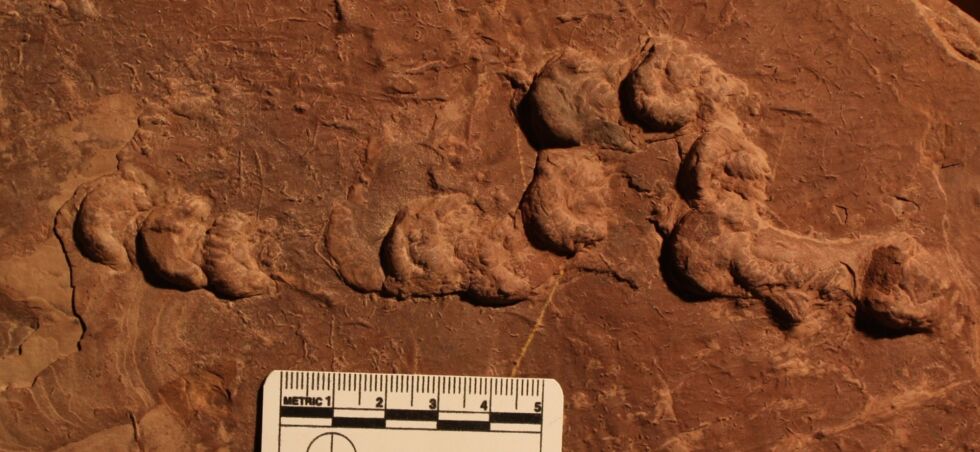In New Mexico, the BLM has had to balance public safety and saving fossils
Blasting has begun in an area known as “Community Pit #1” near Las Cruces, New Mexico, as part of a three-year effort by the Bureau of Land Management (BLM) to level dangerous high walls left in a once heavily mined pit (among other work). But the site is the only known location of certain fossils in the entire state, and some experts question whether the BLM is doing all that it can to balance maintaining public safety and preserving the fossils it is tasked with protecting.
In the Pit
The Community Pit is an area of approximately 85 acres near Prehistoric Trackways National Monument, which hosts a large range of vertebrate footprints. It became a source of building material in 1969, but this use ended in 2007. Scars from several decades of mining remain in the form of very high, very unstable rock walls. Current remediation efforts started because the “BLM observed an increase of visitors climbing upon and underneath undercuts and high walls,” explained William Wight, the BLM Las Cruces District spokesperson. “Due to increased reporting of this dangerous situation in late 2022, the BLM Las Cruces District Office made the Community Pit #1 public health and safety project a top district priority.”
The scope of that project involves “blasting, recontouring, seeding, and re-establishment of vegetation” in about 50 acres of the Community Pit. Blasting will largely impact the top layer of sediment making up the 150-foot walls. It is the rock layer lower in the pit—a geologic formation known as the Robledo Mountain Formation—that contains the fossils unique to the Community Pit: resting and burrowing traces made by jellyfish and horseshoe crabs from the Early Permian (approximately 290 million years or so ago). This is the only known location of jellyfish and horseshoe crab traces in New Mexico.

New Mexico Museum of Natural History and Science
The BLM Environmental Assessment for this project acknowledges that the heavy equipment used to move the blasted material and reshape the area may damage these fossils and “reduce their scientific value.” It also notes that other layers at the site, which could also be impacted, have “very high potential for scientifically important vertebrate and invertebrate trace fossils…”
Balancing science and safety
Long before the current project, paleontologists advised the BLM Las Cruces District office on preserving the fossils within the Community Pit. One of those paleontologists is Spencer Lucas, curator of paleontology at the NM Museum of Natural History & Science, whose work at the site is cited extensively in the BLM’s Environmental Assessment. In an interview with Ars, Lucas said he and his scientific colleagues recommended—not once, but twice—that the BLM preserve fossils within the Community Pit and make an outdoor exhibit to showcase features exposed by the mining. They recommended doing so in conjunction with making the pit safer for the public.
The first set of recommendations, he said, were made in 1994 in an unpublished BLM report created by Lucas and his colleagues. Similar suggestions were made to the BLM in another report he co-authored in 2013. The BLM ignored them, he says.
When asked about this, Wight explained that these reports were considered, but in order to “facilitate and ensure public safety, the action BLM is taking is necessary.” Public exhibits, he said, would have to wait for a future planning process.
Ensuring public safety and protecting fossils are not necessarily mutually exclusive. And the BLM will have a paleontologist monitor the area prior to and after blasting. Beyond that, things are flexible. “The day-to-day tasks of paleontological monitoring,” Wight stated, “will adapt and adjust as material is exposed that could potentially contain trace fossils. Duration of monitoring is as needed.” Should a worker happen to notice the tiny trace fossils and halt construction, the initial person authorized to decide how best to proceed will be a BLM manager.
Workers and machine operators will be trained to know what to look for through a program known as ‘Worker’s Environmental Awareness Program (WEAP)’. Trace fossils, however, can be challenging to identify even for experienced ichnologists (those who study trace fossils). Perhaps more importantly, at this site, “most of these traces are the size of a half-dollar or smaller,” Lucas said. “So how are you going to see them, especially from a bulldozer or a truck?”
Source link
